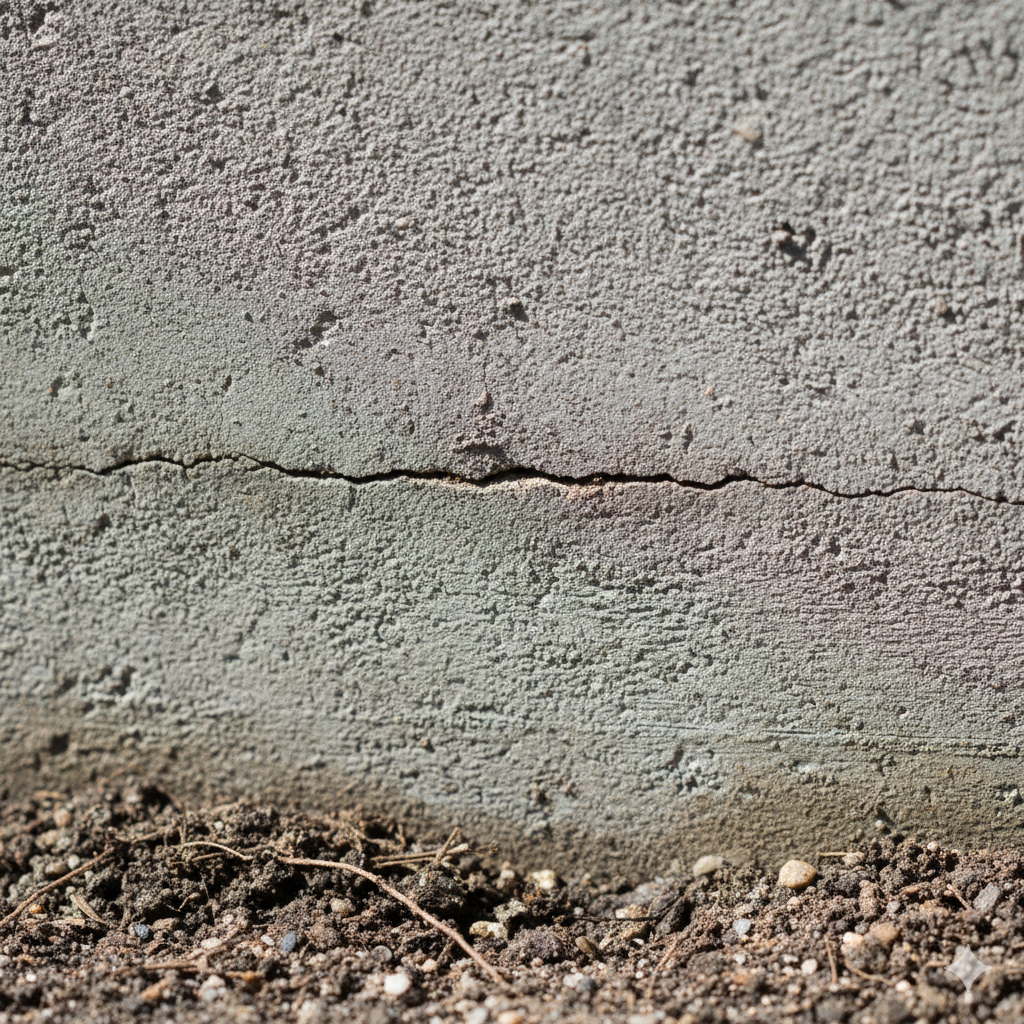The Hidden Dangers of Foundation Cracks: What to Look For
Don’t ignore that hairline crack! Learn how to spot the early signs of foundation problems and why a professional inspection is crucial to protecting your biggest investment.
In the world of homeownership, few phrases are as unsettling as “foundation issues.” The foundation is, quite literally, the bedrock of your home. It’s the sturdy base that everything else—the walls, the floors, the roof—is built upon. When something goes wrong with it, the ripple effects can be catastrophic, leading to costly repairs, devaluation of your property, and, in severe cases, safety hazards.
Yet, many homeowners and potential buyers overlook the most common warning signs: cracks. It’s easy to dismiss a small, hairline crack as a normal part of a home’s settling process. But what if that seemingly insignificant crack is a symptom of a much larger, hidden danger? Knowing what to look for and when to call a professional can be the difference between a minor repair and a major structural nightmare.
At Private Home Inspection, we believe that every homeowner and homebuyer deserves to have a complete, clear picture of their property’s health. In this comprehensive guide, we’ll dive deep into the world of foundation cracks, helping you understand what they are, what they mean, and, most importantly, why you should never ignore them.
The Three Main Types of Foundation Cracks
Not all cracks are created equal. The type of crack, its size, shape, and location can tell you a lot about the underlying cause. While a professional inspector is needed for a definitive diagnosis, understanding these basics can help you identify a potential problem early.
1. Hairline Cracks (Vertical and Diagonal)
These are the most common and, in many cases, the least worrisome. Hairline cracks are typically less than 1/8 of an inch wide and appear as straight vertical lines or at a 45-degree angle.
- Vertical Cracks: These are often a normal part of the home settling process. As a house settles into its new footprint, minor shifts in the ground can cause small, straight cracks. These are usually not a major concern unless they start to widen or if you see water leaking through them.
- Diagonal Cracks: These cracks, also known as stair-step cracks, can be a bit more concerning. They often appear on block or brick foundations and can be a sign of a small differential settlement—meaning one part of the foundation is sinking more than another. While a single diagonal crack may be harmless, a pattern of them could indicate a more serious issue.
2. Horizontal Cracks
These are almost always a major red flag. Horizontal cracks run parallel to the ground and are a strong indicator of significant foundation movement.
- Causes: Horizontal cracks are typically caused by hydrostatic pressure—the immense force of water buildup in the soil surrounding the foundation. When the soil becomes oversaturated, it swells and pushes against the foundation wall, causing it to bow inward and crack.
- The Danger: This type of damage can compromise the structural integrity of your foundation, making it highly susceptible to collapse. Any horizontal crack, no matter the size, warrants immediate professional attention.
3. Stair-Step Cracks
Often found in brick or concrete block foundations, these cracks follow the mortar lines, looking like a set of stairs.
- Causes: Stair-step cracks are a classic sign of differential settlement, where one portion of the foundation is sinking faster than the rest. This can be caused by uneven soil moisture, poor soil compaction, or even tree roots.
- The Danger: While a single, thin stair-step crack might be minor, if they are numerous, wide, or accompanied by other signs of damage, they are a clear indication of a foundation problem that needs to be addressed.
What Causes Foundation Problems? The Root of the Issue
Understanding the “why” behind foundation cracks is key to knowing when to act. The causes are often tied to soil, water, and climate.
- Soil and Settlement: The ground beneath your home is constantly shifting. Soil expands when it gets wet and contracts when it dries out. This natural expansion and contraction can put immense pressure on your foundation, leading to cracks. Over time, your home will settle, but an excessive or uneven settlement can cause significant damage.
- Poor Drainage: This is perhaps the most common culprit. If your home’s downspouts or grading direct water toward the foundation instead of away from it, the soil around the foundation will become saturated. This leads to hydrostatic pressure, which, as we discussed, causes horizontal cracks and bowing.
- Tree Roots: Large trees planted too close to the foundation can be a serious problem. The roots can seek out water under the foundation, causing the soil to dry out and shrink. This creates voids that the foundation can sink into, leading to cracks.
- Plumbing Leaks: An undetected plumbing leak under your slab or in the crawlspace can saturate the soil, leading to the same issues as poor drainage.
- Poor Construction: In some cases, foundation problems are the result of poor soil preparation or shoddy construction from the start.
The Hidden Dangers of Ignoring Cracks
Ignoring a foundation crack is like ignoring a check engine light in your car. It might seem harmless at first, but it can lead to far more serious and expensive problems down the road.
1. Structural Damage
This is the most obvious and most severe danger. If a crack is a sign of structural failure, the consequences can be dire. Walls may start to bow, floors can become uneven, and in the worst-case scenario, parts of your home could collapse. Even a seemingly small issue, if left unaddressed, can compromise the entire integrity of the building.
2. Water Intrusion and Flooding
A crack in your foundation is an open invitation for water. As water seeps through, it can cause flooding in your basement or crawlspace, leading to a host of other problems. Flooding can damage personal belongings, ruin drywall and flooring, and create a breeding ground for mold.
3. Mold and Mildew
Water intrusion is the number one cause of mold. Mold thrives in dark, damp environments like basements and crawlspaces. Exposure to mold can lead to serious health issues, including respiratory problems, allergic reactions, and other illnesses. A professional home inspection can include a mold test to ensure your home’s air quality is safe.
4. Pest Infestation
Cracks in your foundation are an open door for pests. Small insects, rodents, and termites can easily crawl through these cracks and into your home. This can lead to health and safety issues, not to mention a costly pest control bill.
5. Property Devaluation
When it comes time to sell your home, foundation problems are one of the biggest red flags for a potential buyer. An inspection report that lists foundation issues can cause a deal to fall through or, at the very least, lead to a significant drop in the asking price.
Your DIY Foundation Inspection: What to Look For
While a professional is needed for a true diagnosis, there are several things you can do to monitor your foundation.
- Inside Your Home: Look for signs of structural stress.
- Cracks in drywall, especially around door and window frames.
- Doors and windows that stick or don’t close properly.
- Uneven floors or a “bouncy” feeling in certain areas.
- Cracks in tile floors or vinyl flooring.
- A musty odor in the basement or crawlspace.
- Outside Your Home: The exterior can tell you a lot.
- Cracks: Look for all types of cracks, especially horizontal or stair-step cracks. Pay attention to their width and length.
- Drainage: Check your downspouts and gutters. Do they direct water away from the foundation? The ground should slope away from your home.
- Landscaping: Are there large trees or shrubs planted too close to the foundation?
- Bowing Walls: Look for any walls that appear to be bowing or leaning inward. This is a very serious sign of hydrostatic pressure.
Why a Professional Home Inspection is Crucial
As a homeowner, your DIY inspection is a great start. But a professional home inspection is the only way to get a true picture of your foundation’s health. Here’s why you can’t rely on your own two eyes alone:
- Expertise and Training: A certified home inspector is trained to spot subtle signs of foundation damage that you might overlook. They know the difference between a harmless hairline crack and a serious structural issue.
- Advanced Tools: We use advanced tools like moisture meters, laser levels, and thermal cameras to find issues that are invisible to the naked eye. We can detect hidden leaks and moisture behind walls, find subtle changes in elevation, and identify potential problems before they become visible.
- Comprehensive Report: Our reports are comprehensive, easy to read, and include photos and clear recommendations. They provide you with the information you need to make an informed decision and can be your best tool for negotiating repairs.
- Beyond the Foundation: A home inspection is a full-body check-up for your home. We look at everything from the roof and attic to the HVAC system and electrical panel, providing you with a complete picture of your property’s health.
Don’t Wait Until It’s Too Late
A foundation is designed to last a lifetime, but it needs to be cared for and monitored. Don’t wait until a small crack becomes a major problem. Whether you’re a new homebuyer or a current homeowner, a professional inspection is the most important investment you can make in your property’s future.
At Private Home Inspection, we are here to help. We have the knowledge, the experience, and the tools to give you the peace of mind you deserve. Our thorough inspections will help you find the hidden dangers, protect your investment, and ensure the safety of your home.
Don’t guess. Don’t assume. Get your eyes on the inside before you sign.
Contact Private Home Inspection today to schedule your comprehensive inspection and protect your home’s foundation.

